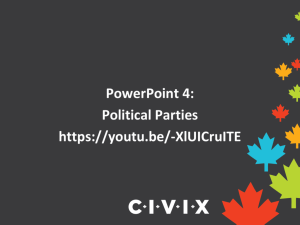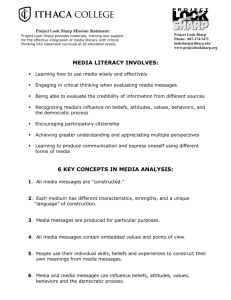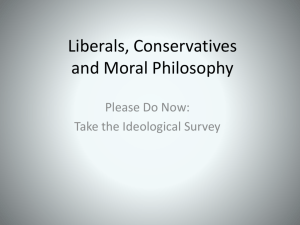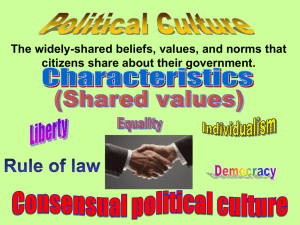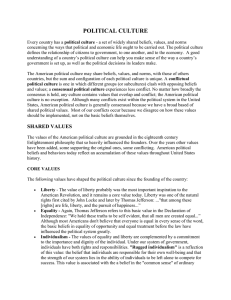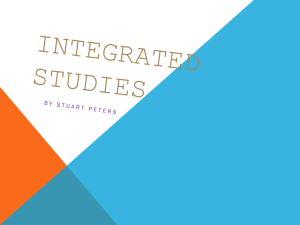Political Beliefs & Behaviors Public Opinion Definition
advertisement
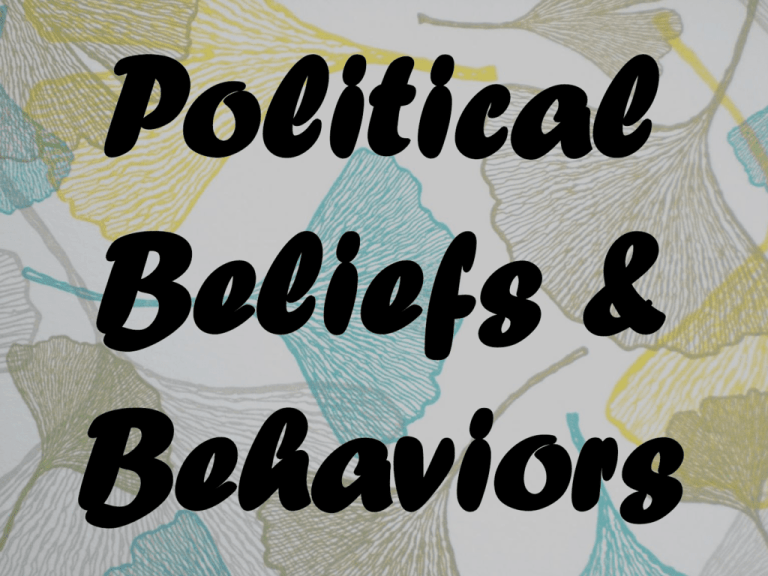
Political Beliefs & Behaviors Public Opinion • Definition: how people think or feel about particular things – Issues – Candidates – Political institutions • Encompasses attitudes of millions of diverse people – Racial, ethnic, age, regional groups – Makes studying American public opinion very complex • Public opinion must reach & become part of the political process in a democracy Measuring Public Opinion • Involves careful interviewing procedures & question wording – Loaded or emotional words should be avoided – Pollster should not indicate what the “right” answer is • Polls – surveys of public opinion – must be carefully executed to reflect public opinion – Random Sample – selecting from a population in which each person has equal probability of being selected – Sampling error – difference between results of random samples taken at the same time – Exit polls – polls based on interviews conducted on Election Day with randomly selected voters Public Opinion Polling • Developed by George Gallup in 1932 – Founded a firm in Princeton, NJ that spread throughout the democratic world • Polling conducted by private firms, TV networks, magazines, newspapers, etc. • Pollsters also hired by political candidates to measure popularity & direct political campaigns • Begin when someone wants a question answered • Factors that Influence Political Attitudes Group identifications often influence political attitudes • Attitudes shaped by political socialization, a lifelong process of acquiring opinions through contact with family, friends, coworkers, the media, or other groups • Family, gender, religion, education, social class, race, ethnicity, and region contribute to political attitudes & behavior • Family Factors Influencing Attitudes – Probably most important source of political socialization – Influences party identification: majority of young people identify with parents’ political party – Lower correlation today than in the past – Growing number of “independents” rather than Republicans or Democrats – If family is more politically active, you are likely to hold the same beliefs • Gender – Gender Gap – difference in political views between men and women – Specific issues • Consider sexual harassment more serious than do men • More men support military actions than women – Party identification affected, but relationships have shifted through the years • Women first more likely to support Republican party than men • Reversed in the 1960s when women became more likely to vote Democrat than men • No clear correlation for women supporting female candidates Factors Influencing Attitude • Married VS Unmarried – Single more likely to vote for Democratic candidates – Married more likely to support Republicans • Religion – Relationships not as strong as they once were – Protestants more conservative on economic matters than Catholics and Jews – Jews more liberal on economic & social issues than Catholics & Protestants – Catholics more liberal on economic issues than on social issues – Christians tend to have conservative views on social issues like abortion, civil rights for minorities, and women’s rights (but not necessarily foreign affairs or economic issues) – Church-goers more likely to vote for Republicans and non-Church goers for Democrats Factors Influencing Attitude • Education – Higher educational level conservative political points of view – College education often influences individuals to have more liberal social & economic attitudes • Social Class – Less clear relationship than before, but: higher social class, more conservative & likely to be Republican • Factors Influencing Race & Ethnicity Attitudes – African Americans more likely to identify with Democratic Party & be more liberal – Hispanic Americans also likely to be liberal Democrats – Asian Americans also likely to vote Democrat • Less research than on other groups • Attitudes vary by nationality • Geographic Region – People on either coast more liberal than those in the middle of the country – Urban/rural differentiation: coastal cities inhabited by minorities, immigrants, and members of labor unions – From Reconstruction-1950s, the Solid South voted Democratic, but more have become affiliated with Republican Party since then Cleavages in Public Opinion • Smaller groups exist within society • We can predict how most people within a category – cleavage – will view issues • Demographics – study of characteristics of populations – Examples: women, men, African Americans, Catholics, Young Adults, College Educated – Socioeconomic Status – division of the population based on occupation, income, and education – Race – grouping of human beings with distinctive characteristics determined by genetics • Examples: Black, Hispanic, Asian, Caucasian • Often distinguishable by appearance – Ethnicity – Social division based on national origin, religion, language, and shared culture • Examples: Jewish, Polish, Han Chinese, Navajo • Emphasize the culture • Types of Cleavages in Social class (SES)Public Opinion – Occupation depends more on schooling, so upper-class exposed to liberal views – Non-economic issues now define liberal & conservative • Race & ethnicity – – – – Becoming more important in non-racial matters Blacks most consistently liberal group within Democratic Party Hispanic & Asian Americans less liberal, but still liberal Whites fairly evenly divided within political spectrum • Region – Southerners & mountain westerners more conservative than northerners & west coasters regarding military & civil rights issues – Southerners more accommodating of business • Prevailing issues – – – – – – – Social security Abortion War on Terror Environment Welfare Healthcare Immigration Types of Cleavages • Reinforcing Cleavage – divisions within society that reinforce one another, making groups more homogenous – A person’s background puts him in the same camp with the same friends over all or most issues – Strengthen political differences – Reduces incentive to compromise – May lead to violence – Makes democracy difficult – Often race-based on the US • Black, urban, poor • Hispanic, rural farm-working poor • Cross-Cutting Cleavage – divisions that cut across demographic categories to produce groups that are more heterogeneous – A person’s background puts him in different camps depending on the issues – Tempers conflict – Engenders compromise – Enables stable democratic decision-making – Common in US & most industrial societies Discussion Topics • Why might people of similar background share opinions on controversial issues? • What issues are prevalent in politics today & how do citizens of Hackettstown feel about them? Political Beliefs • Beliefs that citizens hold about government and its leaders • Different from political ideology – a coherent set of values & beliefs about public policy Political Culture • Definition: common set of beliefs & attitudes about government and politics • American Democratic Values – United under common political culture – Consensus of basic concepts that support democracy • • • • • • Majority rule & minority rights Equality Private property Individual freedoms Compromise Limited government – Americans tend to be more nationalistic, optimistic, and idealistic than people in other countries Core Values • Liberty – freedom to do as you please • Equality – equal opportunity & treatment before the law • Individualism – importance & dignity of the individual • Democracy – government based on consent of the people • Rule of Law – necessary to have body of law applied equally, impartially, and justly • Civic Duty – sense of community & individual responsibility to support community efforts • Changing Values Economic changes spurred by the Industrial Revolution altered American values – Capitalism – wealth based on money & capital goods – added to wealth based on land ownership – Free Enterprise – economic competition without restraint from government • In 1930s, Great Depression brought trouble & the New Deal was an affirmation of gov’t responsibility for welfare of its people – Promotion of General Welfare • Political tolerance – reasonable tolerance of other opinions & actions – Believe in freedom of speech, religion, & petition at least in the abstract – People are not as tolerant as they proclaim to be – Becoming more tolerant over past few decades – Most people dislike another group strongly enough to deny it political rights, but not always inclined to act on those beliefs (Neo-Nazis, LGBT, black militants) Our Political Culture • Mistrust of the government – Trust in gov’t and its officials has declined since mid-1960s • Vietnam War • Watergate • Continued since • Drop in political efficacy – capacity to understand & influence political events – Internal Efficacy – ability to understand & take part in political affairs – External Efficacy – belief of the individual that the government will respond to his personal needs or beliefs Culture Wars • Two cultural camps in constant combat with one another • Some believe the US is subject to relatively unchanging standards that are relatively clear: belief in God, laws of nature, US as a force of good in the world • Others emphasize legitimate alternatives to those standards and that the US has had a negative effect on world affairs Journal Entry • Do you feel the Core American Values are still relevant today? – Liberty, Equality, Individualism, Democracy, Capitalism, Individualism, Rule of Law, & Civic Duty • Which ones are the most prominent in our society? • Which ones are not that important anymore? • Are there any values you think we should add? Political Socialization • Agents of Socialization – Family – Schools – Peers – Mass Media – Religion • Teach you how to live in society • Shape beliefs & values Family • Families are primary agents of socialization • Most children adopt political views of parents • Transfer of political beliefs from one generation to the next – Not always a discussion at the dinner table, but can be! • Is it genetic? – Identical twins are more likely to share similar political views than fraternal twins – Roughly 1/3 of differences among people about political beliefs comes from genetic makeup – 1/10 of differences come from family influences – Half of our political views come from family & half from life experiences • Beliefs aren’t the same as party affiliation – Can be a liberal Republican or conservative Democrat – Party affiliation dependent on what we learn from parents • Party affiliation declining – Ability of family to instill a strong sense of party affiliation has declined in recent years – Younger voters have weaker sense of partisanship than older voters – Age-related differences in opinions on issues that break ideological molds (gay marriage, women’s rights, etc.) Religion • Also linked to family • Religious differences make for political differences – More complicated than at first glance – Usually social issues: abortion, gay marriage, LGBT Rights, war • Opinions vary within given religious traditions School • Primary school includes indoctrination – What it means to be an American – Patriotism – Teach political involvement (voting, protest, etc.) • Later grades give opportunity for questioning society, politics, government, the status quo… • Encounter more controversial vies in & out of the classroom in college – May resonate or challenge existing views – Opportunities to participate in politics on campus Peers & Community • Teenagers: peer pressure is less evident in developing political values – Unless it directly affects you, like a war draft or minimum wage • Later on, peers are often in your same occupation – Professionals like teachers or doctors often have similar political opinions on matters related to their careers Mass Media • TV shows, news reports, magazines, celebrities, Facebook pages, Twitter feeds, Instagram accounts – they all shape your political opinion! • Provide information about relevant issues: drugs, abortion, crime, war, etc. – It all has some bias – Leads to political discussion – You shape opinions based on the information & how it is presented & sometimes who supports the same idea • You are also biased in your interpretation of information – Selection Bias – read or watch sources that reinforce your own views – Perception Bias – miss or ignore contradictions to your views Components of Political Opinions • Once you have a political opinion, it will have 4 components • Direction – pro or con • Degree – strongly or mildly for or against • Salience – how the issue affects your life directly • Intensity – degree of commitment (what will you do as a result? Vote, write letters, protest, get arrested?) • Example: A vegan with an organic farm would have a very strong opinion in support of legislation that limits GMOs. That issue is salient to the farmer and depending on the person, she may protest GMOs to get her point across. Political Ideology • Definition: Consistent set of beliefs about what policies governments ought to pursue • Measured in two ways – How frequently people use broad political categories (liberal, conservative, or radical) to describe views or justify preferences – Consistency of a citizen’s preferences over time or if based on consistent principles at any one time • How accurately can you predict a person’s view on a topic • • • • Moderates are largest group among American voters Conservatives are second largest Liberals are smallest Self-identification surveys don’t tell us how or whether most people think about politics in an ideological manner – Don’t feel need to be “consistent” – Ask variety of questions & fit into series of categories Political Spectrum Liberals & Conservatives • Terms’ meanings have changed over time – Liberals disapproved of strong central government – Conservatives believed government was best left to political elites – Reversed in 1930s with New Deal • Terms do capture views held by many people in the political elite – Often refers to activists in the US – Greater consistency among political elites for several reasons • More information more interest in politics more consistency • More active more association with people who agree with you & start matching their views on other topics – Elites raise & frame political issues in the media (environmentalism, problems abroad, etc.) – Sate norms by which issues should be settled (AIDS example: fear support) • See Liberals & Conservatives Chart Political SPectrum
